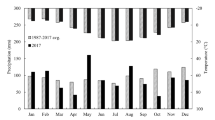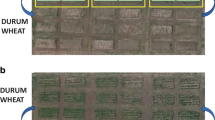Abstract
Because potatoes emerge slowly following planting, soils are susceptible to erosion. Planting a fast emerging nurse crop as a short-term cover crop could reduce potential soil erosion. In 2016 and 2017, research was conducted to address nurse crop seeding rates, necessity to kill the nurse crop with an herbicide, and optimal nurse crop growth period before destroying it through hilling. Winter rye (Secale cereale L.) plots were sown at 2.5 and 5 million seeds ha−1, hilled or killed with herbicide prior to one-pass hilling, and allowed to grow for approximately three or four weeks. Allowing nurse crops to grow four weeks without use of an herbicide prior to hilling appeared to reduce yields one year in two. Grown for three weeks, nurse crops provided effective soil protection and did not affect potato yield or nitrogen status at either seeding rate with or without herbicide use.
Resumen
Debido a que las papas emergen lentamente después de plantadas, los suelos son susceptibles a la erosión. Sembrando un cultivo de cobertura de rápida emergencia, como una cubierta de corto plazo, pudiera reducir la erosión potencial del suelo. En 2016 y 2017, se condujo una investigación para identificar niveles de siembra de un cultivo de cobertura, la necesidad de matar a dicho cultivo con un herbicida, y el período óptimo del cultivo de cobertura antes de destruirlo mediante el aporque. Se sembraron lotes de centeno blanco (Secale cereale L.) en una densidad de 2.5 y 5 millones de semillas ha-1, con aporque o muertas con herbicida antes de un paso de aporque, y se les permitió crecer por aproximadamente tres o cuatro semanas. Al permitir los cultivos de cobertura, su crecimiento por cuatro semanas sin el uso de herbicidas antes del aporque pareció reducir los rendimientos en uno de dos años. Cultivados por tres semanas, los cultivos de cobertura proporcionaron protección efectiva del suelo y no afectaron el rendimiento de papa o la situación del nitrógeno a ningún nivel de semilla con y sin el uso de herbicida.







Similar content being viewed by others
References
Bohl, W.H., P. Nolte, G.E. Kleinkopf, and M.K. Thornton. 1995. Potato seed management: Seed size and age. Publication - AS 1031. University of Idaho Cooperative Extension.
Brink, G.E., and G.C. Marten. 1986. Barley vs. oat companion crops: I. forage yield and quality response during establishment. Crop Science 26: 1060–1067.
Dabney, S. 1998. Cover crop impacts on watershed hydrology. Journal of Soil and Water Conservation. 53 (3): 207–213.
Firman, D.M., P.J. Obrien, and E.J. Allen. 1992. Predicting the emergence of potato sprouts. Journal of Agricultural Science 118: 55–61.
Gardner, B.R., and J.P. Jones. 1975. Petiole analysis and the nitrogen fertilization of russet Burbank potatoes. American Potato Journal 52: 195–200.
Hall, M.H., W.S. Curran, E.L. Werner, and L.E. Marshall. 1995. Evaluation of weed control practices during spring and summer alfalfa establishment. Journal of Production Agriculture 8: 360–365. https://doi.org/10.2134/jpa1995.0360.
Johnson, S. 2010. Potato facts: Selecting, cutting and handling potato seed. Extension bulletin #2412. University of Maine Cooperative Extension.
Ketterings, Q.M., S.N. Swink, S.W. Duiker, K.J. Czymmek, D.B. Beegle, and W.J. Cox. 2015. Integrating cover crops for nitrogen Management in Corn Systems on northeastern U.S. dairies. Agronomy Journal 107: 1365–1376. https://doi.org/10.2134/agronj14.0385.
Knowles, N.R., and L.O. Knowles. 2006. Manipulating stem number, tuber set, and yield relationships for northern- and southern-grown potato seed lots. Crop Science 46: 284–296. https://doi.org/10.2135/cropsci2005.05-0078.
Lanini, W.T., S.B. Orloff, R.N. Vargas, J.P. On, V.L. Marble, and S.R. Grattan. 1991. Oat companion crop seeding rate effect on alfalfa establishment, yield, and weed control. Agronomy Journal 83: 330–333.
Melillo, J.M., T.C. Richmond, and G.W. Yohe, 2014. Climate change impacts in the United States: The third National Climate Assessment. U.S. Global Change Research Program, 841 pp. doi:https://doi.org/10.7930/J0Z31WJ2.
North Dakota State University. 2014. Winter rye seeding rates. Accessed 4/2018 at https://www.ag.ndsu.edu/crops/winter-rye-articles/seeding-rate.
Porter, G.A., and J.A. Sisson. 1991. Petiole nitrate content of Maine-grown russet Burbank and Shepody potatoes in response to varying nitrogen rate. American Journal of Potato Research 68: 493–505.
Plumer, M., M. Mellbye, D. Towery and A. Hulting. 2013. Annual ryegrass cover crop management: corn and soybean production. http://fieldcropnews.com/wp-content/uploads/2016/04/ryegrass-management-2013.pdf.
Steele, M.K., F.J. Coale, and R.L. Hill. 2012. Winter annual cover crop impacts on no-till soil physical properties and organic matter. Soil Science Society of America Journal 76: 2164–2173.
United States Department of Agriculture – Natural Resources Conservation Service. 2013. Cover crop planting specification guide. https://www.nrcs.usda.gov/Internet/FSE_DOCUMENTS/stelprdb1081555.pdf
United States Department of Agriculture – Natural Resources Conservation Service. 2010. Aerial seeding of cover crops. Technical Notes. Agronomy #36. https://prod.nrcs.usda.gov/Internet/FSE_DOCUMENTS/stelprdb1167304.pdf.
Vitosh, M., and G.H. Silva. 2008. Factors affecting potato petiole sap nitrate tests. Communications in Soil Science and Plant Analysis 27 (5–8): 1137–1152. https://doi.org/10.1080/00103629609369622.
Acknowledgements
This work was supported by funding from Northeast Sustainable Agriculture Research and Extension grant number: ONE16-283C-29994.
Author information
Authors and Affiliations
Corresponding author
Rights and permissions
About this article
Cite this article
Jemison, J.M. Use of Nurse Crops in Potato Production to Protect Soils from Erosion. Am. J. Potato Res. 96, 13–20 (2019). https://doi.org/10.1007/s12230-018-9684-7
Published:
Issue Date:
DOI: https://doi.org/10.1007/s12230-018-9684-7




